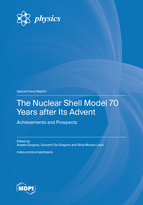The Nuclear Shell Model 70 Years after Its Advent: Achievements and Prospects
A special issue of Physics (ISSN 2624-8174). This special issue belongs to the section "Atomic Physics".
Deadline for manuscript submissions: closed (30 June 2022) | Viewed by 41218
Special Issue Editors
Interests: nuclear structure; nuclear shell model; effective interactions; beta decay
2. Istituto Nazionale di Fisica Nucleare, Complesso Universitario di Monte S. Angelo, Via Cintia, I-80126 Napoli, Italy
Interests: nuclear structure; nuclear shell model; nuclear collective motions; beta decay
2. Istituto Nazionale di Fisica Nucleare, Via F. Marzolo 8, I-35131 Padova, Italy
Interests: nuclear structure; nuclear shell model; nuclear collective motions; nuclear spectroscopy
Special Issue Information
Dear Colleagues,
The shell model (SM) entered into nuclear physics almost 70 years ago after Maria Goeppert Mayer and Hans Jensen - who shared the Nobel prize in 1963 for their work – were able to explain the mystery behind the magic numbers associated with the great stability in the ground state of some nuclides.
The SM is widely considered as the basic scheme of the microscopic description of the nucleus, and, starting from its introduction, has been successfully applied for investigating a variety of nuclear structure phenomena, which have also important implications in our understanding of both astrophysics and physics beyond the standard model.
Within the SM the complexity of the many-body system is simplified by considering the nucleus as a closed-shell core with additional valence nucleons that interact in a subspace of the Hilbert space through effective Hamiltonians, accounting for contributions from configurations outside the model space.
In the last two decades or so, thanks to the high-performance computing facilities available all around the world and the implementation of more and more efficient codes and methods, large-scale SM calculations have become a well-established approach to investigate medium- and heavy-mass nuclei whose description requires large model spaces with many valence nucleons. Today, it is possible to deal with huge matrices of dimension ~ 1011-12, unthinkable up to few years ago.
Over about the same period, the extraordinary improvements in sensitivity and efficiency of the experimental tools together with the development of a large variety of radioactive beams has allowed to explore new regions of the nuclide chart towards the drip lines. The richness of data emerging from these experimental studies has probed the reliability and robustness of the SM in describing the new phenomena observed far from stability such as the onset of collectivity at the historical magic numbers, the development of islands of inversion and the appearance of new magic numbers, the evidence of shape coexistence. These studies have revealed modifications in the shell structure as a function of proton and neutron number, leading to a paradigm shift away from the universality of the magic numbers. Large-scale SM calculations are required to investigate these phenomena and to understand the role of the different components of the nuclear force in determining the evolution of the shell structure towards the driplines.
While the SM has been used predominantly in the past with empirical effective Hamiltonians, substantial progress has been achieved in the last years in deriving the SM input from realistic bare interactions, including two and three-body forces based on chiral effective field theory. This has given a further impulse towards a fully microscopic description of atomic nuclei starting from the quantum chromodynamics degrees of freedom. Within this context, valence-space Hamiltonians can be derived by means of many-body perturbation theory, and only very recently nonperturbative approaches have been introduced.
In this Special Issue, we aim to collect contributions that, starting from the historical setting, may provide a clear overview of the current status and future developments of the nuclear shell model, including its applications in describing a variety of nuclear structure phenomena. For this purpose, we invite articles and reviews to contribute to both experimental and theoretical aspects for inclusion in this Special Issue.
Dr. Angela Gargano
Dr. Giovanni De Gregorio
Prof. Dr. Silvia Monica Lenzi
Guest Editors
Manuscript Submission Information
Manuscripts should be submitted online at www.mdpi.com by registering and logging in to this website. Once you are registered, click here to go to the submission form. Manuscripts can be submitted until the deadline. All submissions that pass pre-check are peer-reviewed. Accepted papers will be published continuously in the journal (as soon as accepted) and will be listed together on the special issue website. Research articles, review articles as well as short communications are invited. For planned papers, a title and short abstract (about 100 words) can be sent to the Editorial Office for announcement on this website.
Submitted manuscripts should not have been published previously, nor be under consideration for publication elsewhere (except conference proceedings papers). All manuscripts are thoroughly refereed through a single-blind peer-review process. A guide for authors and other relevant information for submission of manuscripts is available on the Instructions for Authors page. Physics is an international peer-reviewed open access quarterly journal published by MDPI.
Please visit the Instructions for Authors page before submitting a manuscript. The Article Processing Charge (APC) for publication in this open access journal is 1400 CHF (Swiss Francs). Submitted papers should be well formatted and use good English. Authors may use MDPI's English editing service prior to publication or during author revisions.
Keywords
- nuclear shell model
- effective interactions
- nuclear forces
- nuclear structure
- many-body methods
- high performance computing
- exotic nuclei
- nuclear spectroscopy






